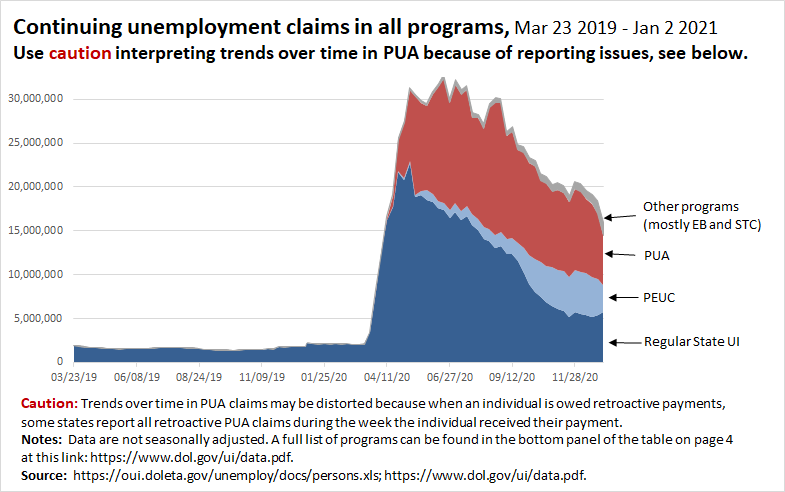
This morning, DOL released some of the last unemployment insurance (UI) claims data of the Trump era. That means this release helps us understand the economy President Biden just inherited. Here we go. 0/
Another 1.3 million people applied for UI last week, including 900,000 who applied for regular state UI and 424,000 who applied for Pandemic Unemployment Assistance (PUA). 1/ dol.gov/ui/data.pdf
The 1.3 million who applied for UI last week was an increase of 113,000 from the prior week. The increase underscores that layoffs are increasing as the virus surges. Total initial claims are now back to roughly where they were at the end of September. 2/
Last week was the 44th straight week total initial claims were greater than the worst week of the Great Recession (GR). (If you restrict to regular state claims—b/c we didn’t have PUA in the GR—initial claims last week were still greater than the worst week of the GR.) 3/
I got some questions about this recently so I should note that I use seasonally adjusted data where I can, but for comparisons over long periods, I use not-seasonally-adjusted data, since DOL’s improved seasonally adjustments aren’t available before August 2020. 4/
Most states provide 26 weeks of regular benefits, meaning many workers are exhausting their regular state UI benefits. In the most recent data (week ending Jan 9), continuing claims for regular state benefits dropped by 127,000. 5/
After a worker exhausts regular state benefits, they can move onto Pandemic Emergency Unemp Compensation (PEUC), which is an additional 24 weeks of regular state UI (the December COVID relief bill increased the number of weeks of PEUC eligibility by 11, from 13 to 24). 6/
However, in the most recent data available for PEUC, the week ending Jan 2nd, PEUC claims *dropped* by 1.1 million. We can expect that reverse in coming weeks. Why? 7/
Over 3.5 million workers had exhausted the *original* 13 weeks of PEUC by the end of December. These workers are now eligible for the additional 11 weeks, but they need to recertify. PEUC numbers will spike dramatically as this occurs. 8/
Continuing claims for PUA also dropped dramatically—by 1.7 million—in the latest data, the week ending Jan 2. This can also be expected to reverse in coming weeks. The December bill extended the total weeks of PUA eligibility by 11, from 39 to 50 weeks. 9/
As workers who exhausted PUA before the extensions were signed get back on PUA, we can expect the PUA numbers to swell. 10/
The 11-week extensions of PEUC and PUA just kick the can down the road—they are not long enough. Congress must provide longer extensions, or millions will exhaust benefits in mid-March, when the virus will still be surging and the labor market will still be weak. 11/
This chart shows continuing claims in all programs over time (the latest data for this are for Jan 2). The recent sharp declines in PUA and PEUC are due to temporary lapses and will be reversed as people get back on the program. 12/ 

There are now 26.8 million workers who are either unemployed, otherwise out of work because of the virus, or have seen a drop in hours and pay because of the pandemic. And layoffs are rising. More relief is desperately needed. 13/ epi.org/blog/the-econo…
Another reason more relief is so important is that this crisis is greatly exacerbating racial inequality. Due to the impact of historic & current systemic racism, Black and Latinx workers have seen more job loss in this pandemic, and have less wealth to fall back on. 14/
Even with the $900B Dec. COVID bill, we still need more than $2 trillion in relief. A key missing piece from the latest bill is aid to state & local govts—w/o it, state & local govt austerity will cost millions of jobs in the public & private sector. 15/ epi.org/blog/without-f…
Biden announced a relief package last week that gets the economics right—it is at the scale of the challenge we are facing and is a clear break from the mistakes we made in past recoveries, when we hobbled the economy by not doing enough. 16/ epi.org/press/presiden…
And with their new majority in the Senate, Democrats can now get crucial relief measures through reconciliation. Top priorities include aid to state and local governments, additional weeks of UI, and increased UI benefits. 17/
You know the drill—here's this tweet thread in a blog post. n/ epi.org/blog/president…
• • •
Missing some Tweet in this thread? You can try to
force a refresh


